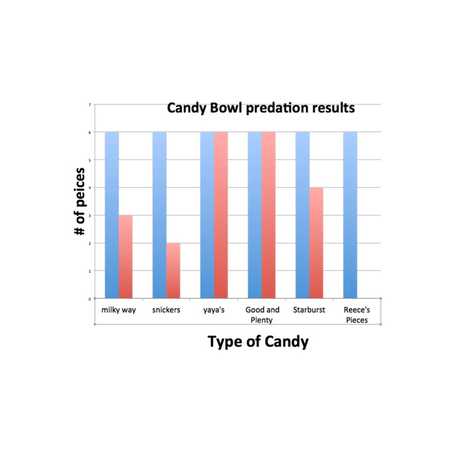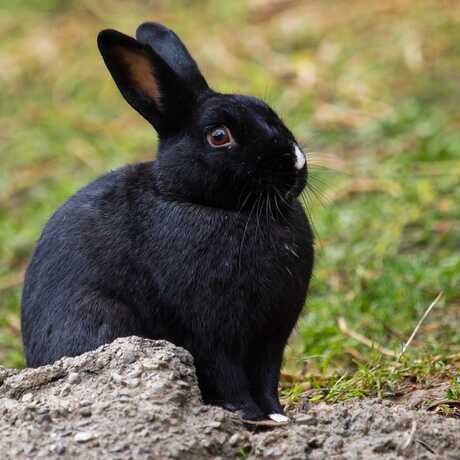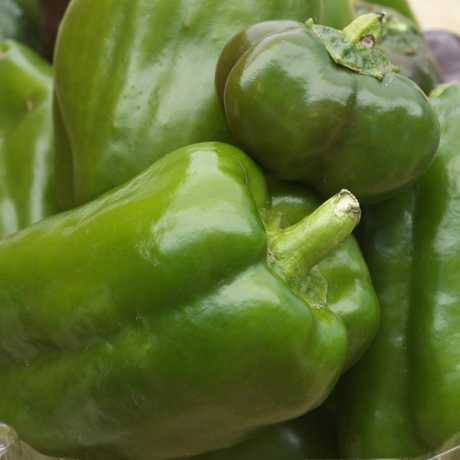
Image Credit: seanmfreese
In this activity, students will unknowingly act as predators on candy. They will then discuss whether their predation was random or whether they had certain preferences. They will graph their results and determine how selective predation can impact a population and cause natural selection.
In this activity, students will:
- experience how selective predation is a form of natural selection.
- create and interpret predation data.
- bowl(s)
- 6 types of individually wrapped candy
- tally table on whiteboard
- graph (Microsoft Excel, graph paper, or on board)
- fitness: the ability of an organism to survive and produce viable offspring in a particular environment; or the reproductive success of an organism in a particular environment
- genotype: the genetic makeup of an organism; all of the genes and alleles of an organism
- natural selection: the process by which organisms that are better adapted to their environment survive and reproduce at a higher rate than those that are less adapted, resulting in the survivors’ characteristics being more prevalent in subsequent generations. Therefore, natural selection produces changes in the genetic composition of a population from one generation to the next so that alleles that are beneficial for survival become more common, while alleles that are not beneficial decrease. Originally proposed by Charles Darwin, natural selection forms the basis of the process of evolution.
- predation: the act of an organism capturing and feeding on others.
- selective predation: a behavior in which a predator attacks only individuals with certain characteristics in a population of potential prey.
- phenotype: all observable physical and functional characteristics of an organism; it is the product of the genotype and environmental influences
In this (covert) activity, students will unknowingly act as predators on candy. They will then discuss whether their predation was random or whether they had certain preferences. They will graph the class results and determine how selective predation can impact a population and cause natural selection.
- Buy at least 6 different kinds of candy (chocolaty, sugary, etc.). Make sure to purchase more candy than there are students in the class so that you have extra after everyone has taken a piece.
- Count and record the number of candy items that you started with, as you place them in a bowl (or several bowls).
- Make the candy dish accessible in advance so students can pick candies over a period of time, or you can pass the dish around the room a couple times. You can avoid commenting about it at all, or you can make very innocent remarks about providing a treat for the students. But, do not draw too much attention to the candy.
- After more than half of the candy has been removed, gather the class together. Start the discussion by pointing out that there is often great variation among individuals of animal species (and candy). For example, students can look around the room and list the characteristics that vary among humans. Then, ask the students why variation might be significant. (One reason variation is important is that variation allows for differential survival of individuals, but your students may not reach that conclusion just yet.)
- Reference the candy bowl and the remaining candies, informing students that—perhaps unbeknownst to them!—these candies represented prey items. Because of our predation, some of the prey survived and some died.
- Count which candies remain and list them on the board. Ask the students if they remember which candies were originally available. Make a list on the board of the original set of candy.
- Inform students that you secretly counted the number of each candy before class.
- Make a bar graph that compares the candy before and after students made their selections.
- Now ask them to list the traits of the candy they chose from the candy dish. (Examples include: chocolate flavor, large size, favorite brand, etc). These are the traits that led to the removal of certain candies.
- Make a list now of the traits of the candies that were not chosen (examples: bad flavor, small size). These are the traits that allowed the candies to survive being passed around the room.
- Ask students what their predation did to the population. (It decreased the candy population size, but it also changed the composition of the candy population.)
- So, the fact that there were different candies with different traits resulted in some candies being eaten and others surviving. This is what selective predation (a form of natural selection) does with individuals in a population and between populations.

As you review the results as a class, consider introducing some of the scientific terms that are likely to come up in your unit on natural selection.
- Is predation random? Not always, sometimes predation is selective.
- Selective predation is acting on the physical characteristics, or phenotype of an organism—what a predator can observe. Another key type of variation is seen in one's genetic makeup, which is termed one's genotype. (Try out the Genetic Wheel activity next to explore some variation in your class!)
- Imagine the candy in the bowl continued to reproduce, because these species are safe from predators. This is what evolutionary biologists refer to when they say fitness—not physical strength, but one's ability to survive and reproduce in a given environment. How might these candy species have fared in another classroom? Another country? With younger students?
Selective predation is just one agent of natural selection, a process we'll be studying in this unit.
Either now or at the end of your unit, you can critique this demonstration to consider what it models well, and what it leaves out or disregards. For example, if you consider the five basic steps of natural selection using the VISTA acronym (Variation, Inheritance, Selection, Time, and Adaptation), you can see that candies demonstrate variation and are selected against, but are obviously not reproducing over subsequent generations to share genetic code, nor can they adapt. It may not be the appropriate time to dive into all of the mechanics of natural selection now, but you can set the stage.
Evolution is a two step process. First, there must be variation among individuals in a population. Secondly, natural selection acts on the phenotype, or the observable characteristics of an organism, such that individuals with favorable phenotypes are more likely to survive and reproduce than those with less favorable phenotypes. The genotype of the favorable phenotype, will increase in frequency over the following generations Some individuals are more fit in a particular environment and are thus able to pass on their genes to subsequent generations more successfully than other individuals. This process drives evolution within a population. Since it is crucial to both survive and reproduce in order to pass on genes to the next generation, natural selection results from both the differential survival and the differential reproductive abilities of individuals.
There are many forces that affect natural selection. For example, an organism’s environment can change, making some individuals more fit to survive or reproduce than others. Or, a predator can exert selective pressure on a population. Because predators do not capture their prey randomly, but often exhibit preferences, predation can change the composition of a prey’s population. Predator preference is thus an agent of natural selection.
This activity could serve as part of a much larger unit that aims to address the below standards.
Related Performance Expectations
Remember, performance expectations are not a set of instructional or assessment tasks. They are statements of what students should be able to do after instruction. This activity or unit is just one of many that could help prepare your students to perform the following hypothetical tasks that demonstrate their understanding:
MS-LS4-4.Construct an explanation based on evidence that describes how genetic variations of traits in a population increase some individuals’ probability of surviving and reproducing in a specific environment. [Clarification Statement: Emphasis is on using simple probability statements and proportional reasoning to construct explanations.]
HS-LS4-3.Apply concepts of statistics and probability to support explanations that organisms with an advantageous heritable trait tend to increase in proportion to organisms lacking this trait. [Clarification Statement: Emphasis is on analyzing shifts in numerical distribution of traits and using these shifts as evidence to support explanations.] [Assessment Boundary: Assessment is limited to basic statistical and graphical analysis. Assessment does not include allele frequency calculations.]
Disciplinary Core Ideas
LS4B: Natural Selection
6-8: The traits that positively affect survival are more likely to be reproduced, and thus are more common in the population.
9-12: Natural selection leads to the predominance of certain traits in a population, and the suppression of others.
Science and Engineering Practice: Using Mathematics and Computational Thinking
6-8: Use mathematical representations to support scientific conclusions and design solutions.
Crosscutting Concept: Patterns
6-8: Graphs, charts, and images can be used to identify patterns in data.
9-12: Different patterns may be observed at each of the scales at which a system is studied and can provide evidence for causality in explanations of phenomena.
- Adapted from Tang, C. Candy Dish Selection. This activity was first suggested to Dr. Tang by Jack Laws, associate at the California Academy of Sciences.
- Purves, W. K., Sadava, D., Orians, G. H., & Heller, H. C. (2001). Life: The Science of Biology (6th ed.). Sunderland, Massachusetts: Sinauer Associates, Inc.


